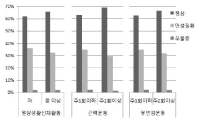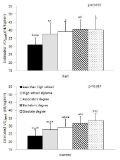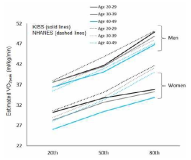PURPOSE This research explores the underlying mechanism that determines how people perceive their goal progress and its relation with their motivation and self-efficacy. METHODS Three hundred and sixty Koreans who participated in an online survey were given salient individual exercise goals (11 workouts), and they reported their self-efficacy, goal progress perception, and motivation. We conducted dummy variable multiple regression analysis (2 [absolute progress-low (27%) vs. high (73%)] X 2 [categorization vs. no-categorization]) and multiple moderated mediation analysis based on Process Model 7 and 21 (Hayes, 2017). RESULTS The findings showed significant interaction between categorization and absolute progress on progress perception. In low progress condition, the categorization group perceived more progress than no categorization group and contrary effect in high progress condition. For motivation, in low progress condition, categorization group was more motivated than no categorization group, and inverse effect in high progress condition. Moreover, there was no direct effect, but only low self-efficacy group played the moderating role between perceived progress and motivation in conditional indirect effect. Lastly, the result indicated significant multiple moderated mediation effect. CONCLUSIONS This research theoretically contributes to the domains of categorization and motivation. Sport marketers can utilize categorization as a strategy by breaking down yearly memberships into monthly categories based on consumers perceptions. Future research can include subsequent motivation after a superordinate goal is completed.
PURPOSE This study investigated the effect of non-linear periodization strength training on basic and professional fitness of national cross-country skiers. METHODS The body composition (height, weight, BMI, body fat %), basic physical strength (grip strength, lung capacity), anaerobic power (peak power, average power), graded exercise test (maximum heart rate, running time, VO2max, lactic acid), isokinetic strength (trunk strength), and 1RM (bench press, dead-lift, squat, shoulder press, leg curl, bicep curl, cable triceps extension) of nine national cross-country skiers (male: 5, female: 4) were measured. All analyses were performed using SPSS 25.0, Kruskal-Wallis H tests were applied to observe the changes by training methods. Mann-Whitney U tests were used as Post Hoc. RESULTS The results indicated that running time and VO2max post-test improved compared to that for the pre-test for graded exercise test. The lumbar extension strength of the post-test was higher than that for pre-test. There was no significant difference in other variables. CONCLUSIONS It is suggested that nonlinear periodization strength training can be expected to improve running time, VO2max, and trunk strength for cross-country athletes; however, it does not affect the overall changes.
PURPOSE This study aimed to investigate the effects of trunk stabilization exercise (TSE) with abdominal expansion maneuver (AEM) that lasted for 8 weeks on postural stability and functional movement in college athletes. METHODS Twenty college athletes participated in the program (AEM=9, Control=11) and were subjected to 8-week TSE. The AEM group performed exercise by applying AEM techniques during TSE, and control group performed TSE without breathing-related instructions. Both groups measured postural stability with lower-quarter Y-balance test (LQYBT) and functional movement with functional movement screen (FMS) before and after applying TSE to verify the interaction before and after this study with the two groups. Two-way repeated analysis of variance was performed to evaluate the differences between groups and time for an absolute value of LQYBT and FMS, followed by Bonferroni’s multiple comparison tests for post-hoc analysis. RESULTS As a result of the left and right LQYBT, there was a significant difference between the time x group (p=.041, p=.033), and post-hoc analysis indicated that there was a significant difference between the AEM and control groups (p=.000, p=,000). Furthermore, the FMS total score indicated that there was a significant difference between the time × group (p=.039), and the post-hoc analysis showed the AEM group had significant results (p=.001), while there were no significant results in the control group (p=.255). CONCLUSIONS Application of AEM during TSE seems to be effective with regard to postural stability and functional movement in college athletes.
PURPOSE This study aimed to examine the effect of acute tart cherry juice intake on recovery after intermittent exercise in female field hockey athletes. METHODS Sixteen university female field hockey athletes were studied for a total of 3 days. The cohort was divided into 2 groups, placebo group (n=8, PLA) and the tart cherry juice group (n=8, TCJ), Each supplement was consumed 5 times over 48 hours. On the first day of the study, venous blood was collected before the test, and physical fitness variables (20m sprint, 5-0-5 agility, and Countermovement jump) were performed twice before and after the Yo-Yo Intermediate recovery test 1 to determine the degree of muscle damage and recovery of physical fitness factors. After all tests on Day 1, supplements (PLA, TCJ) were taken. After 24 hours, venous blood collection was performed, and after 48 hours, venous blood collection and physical element variables were measured to verify the effectiveness of tart cherry juice. RESULTS In the TCJ group, a significant effect was found over time in the 5-0-5 ability among the fitness variable items (p<.001) In Countermovement jump (CMJ), there was a significant effect over group and time (p<.001). Second, significant effects over group and time were shown in Interlukin-6 (IL-6) among variable items related to muscle damage and inflammation through venous blood collection (p<.05) and LDH (p<.001), and CK (p<.01) showed a tendency to decrease with time. CONCLUSIONS The results of this study suggest that acute tart cherry juice intake after intermittent exercise tends to reduce muscle damage and inflammation-related variables in female field hockey players, which could help them recover quickly, especially after hectic game schedules.
PURPOSE The aim of this study was to investigate the effects of 12-week instrumental pilates exercise on isokinetic muscle function and body composition of healthy college women. METHODS Twenty-four college women (aged 21.6±1.3yrs) were recruited to the study. The participants were divided into two groups, as the instrumental pilates group (IPG, n=12) and the control group (CG, n=12). The springboard pilates exercise was conducted 3 times a week for 40~60 minutes during 12 weeks. RESULTS There was significant interaction effects in the right knee and left · right elbow extensor muscles (60°/sec) and left knee flexor and right elbow extensor · flexor muscles (180°/sec)(p<.05, p<.01). There was no significant interaction effects in the muscle mass of the total body, trunk, arms, and legs (NS) and also in the serum growth hormone, insulin-like growth factor-I and 25(OH)Vitamin D (NS). Serum creatine kinase was significantly increased (p<.05). There was also no significant interaction effects in weight, body fat, serum total cholesterol, triglycerides, low & high-density lipoprotein cholesterol (NS). CONCLUSIONS These results suggest that although prolonged instrumental pilates exercise of healthy college women might be improving isokinetic muscle function, there is no increasing effect of muscle mass.

Purpose The study examined the effects of a 12-week high intensity circuit training (HICT) on abdominal fat, physical fitness, blood lipids, and insulin resistance in middle-aged obese women. Methods Thirty obese women, aged 32-48 yrs, were recruited and randomly assigned to either HICT group (TR; n = 15) or control group (CON; n = 15). Subjects in the TR group participated in HICT of which resistance exercise and aerobic exercise were performed with a duration of 40 min/session and 3 sessions/wk for 12 weeks, whereas subjects in the CON group were asked to maintain their normal life patterns. Dependent variables included abdominal fat area, body composition, physical fitness, blood lipids profiles, and insulin resistance index. Analysis of variance with repeated measures with Bonferroni corrections was used to compare the outcomes between two groups. Results Main findings of the present study were as follows: 1) compared to the CON group, the TR group had significant reductions in overall (i.e., body mass index and percent body fat) and abdominal obesity (i.e., waist circumference, total abdominal fat area, visceral fat area, subcutaneous fat area, and visceral fat area-subcutaneous fat area ratio), 2) compared to the CON group, the TR group had significant improvements in health-related physical fitness (i.e., muscular strength, muscular endurance, muscle power, flexibility, balance, and cardiorespiratory endurance), and 3) compared to the CON group, the TR group had significant improvements in fasting lipids, glucose, insulin, and insulin resistance. Conclusions The current findings of the study suggested that HICT would be an effective exercise intervention to improve metabolic complications associated with obesity and poor physical fitness in obese middle-aged women.



The purpose of this study was to investigate the effects of 8 weeks of aerobic training and resveratrol supplementation on a body composition, physical fitness, insulin resistance, liver function, blood pressure, and heart rate. Fifty-one elderly women were randomly assigned to aerobic training group (EX: n=12), resveratrol supplementation group (R: n=13), combined aerobic training and resveratrol supplementation group (EX+R: n=12), and control group (CON: n=14). The subjects in EX group exercised three sessions per week, 40 minutes per session for 8 weeks, the subjects in R group took 500 mg of resveratrol per day for 8 weeks, and the subjects in EX+R group received both treatments. The subjects in CON group were asked to maintain normal daily life pattern without any treatment for the same period of intervention. Body composition, physical fitness, insulin resistance, liver function, blood pressure, and heart rate were measured at pre- and post-test and the data were compared among groups and between tests by utilizing two-way ANOVA with repeated measures. Main results of the present study were as follows: 1) Physique and body composition did not change significantly in all groups. 2) Muscular endurance increased significantly in EX+R group, whereas the other physical fitness-related variables showed no significant changes in all groups. 3) Fasting glucose, fasting insulin, HOMA-IR, and HbA1c tended to be improved in EX+R group. 4) AST, ALT, and γ·GT showed no significant changes in all groups. 5) Systolic blood pressure and diastolic blood pressure increased significantly in CON group. Heart rate tended to be decreased in EX+R group and EX group. It was concluded that the 8 weeks of aerobic training and resveratrol supplementation had positive effects on muscular endurance, insulin resistance, and blood pressure in T2DM elderly women. Research investigating the effects of a longer period of aerobic training and resveratrol supplementation on the same variables would be warranted in the future.
This study was designed to examine the effects of 12 weeks of resistance exercise training on physique, body composition, insulin resistance, and blood lipid profiles in 20s normal weight obese females. Sixteen females were randomized into one of following two groups: resistance training group (RT group; n=8) and control group (CON group; n=8). Subjects in RT group completed 12 weeks of resistance exercise training for three times/wk, and subjects in CON group were asked to maintain their normal life pattern during the same intervention period. Data were analyzed using two-way repeated measures ANOVA with post hoc test. Main results of the present study were as follows: 1) Body weight, BMI, waist circumference, hip circumference, WHR, and WHtR decreased significantly in RT group. 2) All variables regarding body composition did not change in both groups; however, fat mass was tended to decrease more in RT group than CON group. 3) Fasting plasma glucose decreased significantly in both groups, whereas other variables regarding insulin resistance did not change significantly in both groups. 4) All variables regarding blood lipids did not change significantly in both groups. Results indicate that 12 weeks of resistance exercise training was beneficial in physique and body composition; however, it was not beneficial in insulin resistance and blood lipid profiles in 20s normal weight obese females. Future research including normal weight obese subjects with higher age would be warranted to elucidate more clearly the effects of resistance exercise training on metabolic status.

This study examined the association between physical activity (PA) and the prevalence of chronic disease and chronic depression. Additionally, the relationships between PA and health-related quality of life (HRQoL) among general population, categorized by healthy, chronic disease and depression were investigated. Cross-sectional data includes 9,739 participants (4,351 males, 5,659 females, over 19 years old) who completed physical activity, chronic disease and HRQoL questionnaires from The Fifth Korea National Health and Nutrition Examination Survey (KNHANES). Complex samples frequency, descriptive, cross-tab and logistic analysis were used. Estimated prevalence of chronic disease and depression were significantly different between PA levels and frequency. Based on odds ratios (OR) and 95% confidence intervals (CI), participating in lower levels of daily PA including less resistance and flexibility exercise were associated with an increased likelihood of chronic disease. Less frequency of resistance PA was also associated with an increased likelihood of depression. Estimated prevalence of HRQoL was different according to PA in the healthy and chronic disease populations. Adjusted OR and confidence intervals represented through lower levels of daily PA and less frequency of resistance PA were associated with an increased likelihood of poor HRQoL in the chronic disease population. No significant OR between PA and HRQoL in the depression population was observed.


To provide the distribution of cardiorespiratory fitness including Bruce treadmill exercise time and estimated peak oxygen uptake (VO2peak) and investigate association with cardiorespiratory fitness and metabolic syndrome, sedentary lifestyle, or education level among Korean adults. Analysis of data on 2,006 adults (19-64 yr) who had completed a maximal grade treadmill exercise test, from the Sports Institute of Sports Science Fitness Standards (KISS FitS) project 2014-2015. The mean maximal exercise time was 11’26’‘, 11’18’‘, 11’06’‘, 10’03’‘ and 8’51’‘ (minutes and seconds) for men 19-29, 30-39, 40-49, 50-59 and 60-64 years of age, respectively, for women, it was 9’49’‘, 9’09’‘, 8’42’‘, 8’01’‘ and 7’33’‘ for the corresponding age groups. The mean peak oxygen uptake was estimated as 42.3, 41.8, 41.2, 37.6 and 33.6 ml/kg/minute for men 19-29, 30-39, 40-49, 50-59 and 60-64 years of age, respectively, For women, it was 34.0, 31.8, 30.3, 28.0 and 26.4 ml/kg/minute for the corresponding age groups. A positive association between cardiorespiratory fitness level and education level was observed for both men and women. Furthermore, participants with sedentary lifestyle had a significantly lower cardiorespiratory fitness than participants with activity lifestyle. Finally, Men with moderate and high fitness level had 50% and 87% lower odds for the metabolic syndrome, and women had 48% and 50% lower odds for the metabolic syndrome, respectively, than the ones with low fitness level after adjustment for age, smoking, alcohol intake, and sedentary lifestyle. These results can be used to track future Korean assessments and to evaluated interventions. The differences in fitness status by education level, sedentary lifestyle or metabolic syndrome can also be used to develop health policies, program and educational services.


